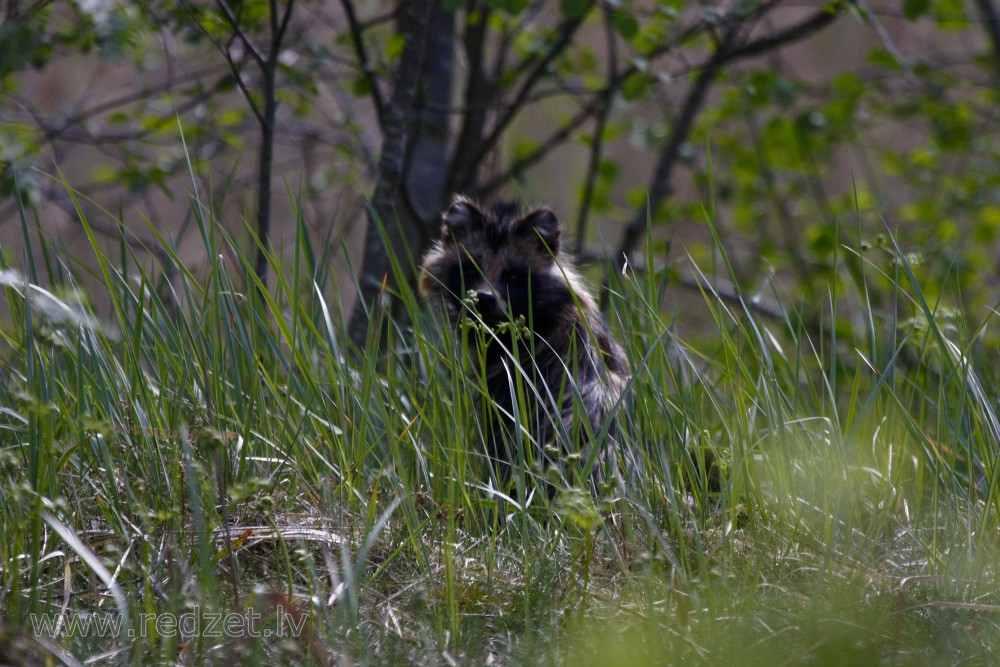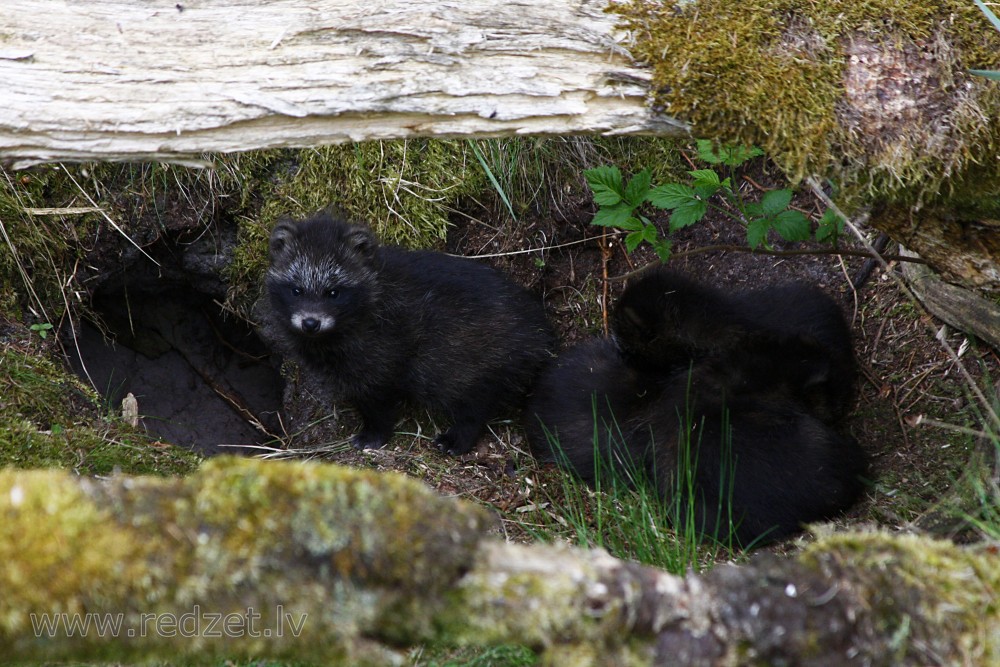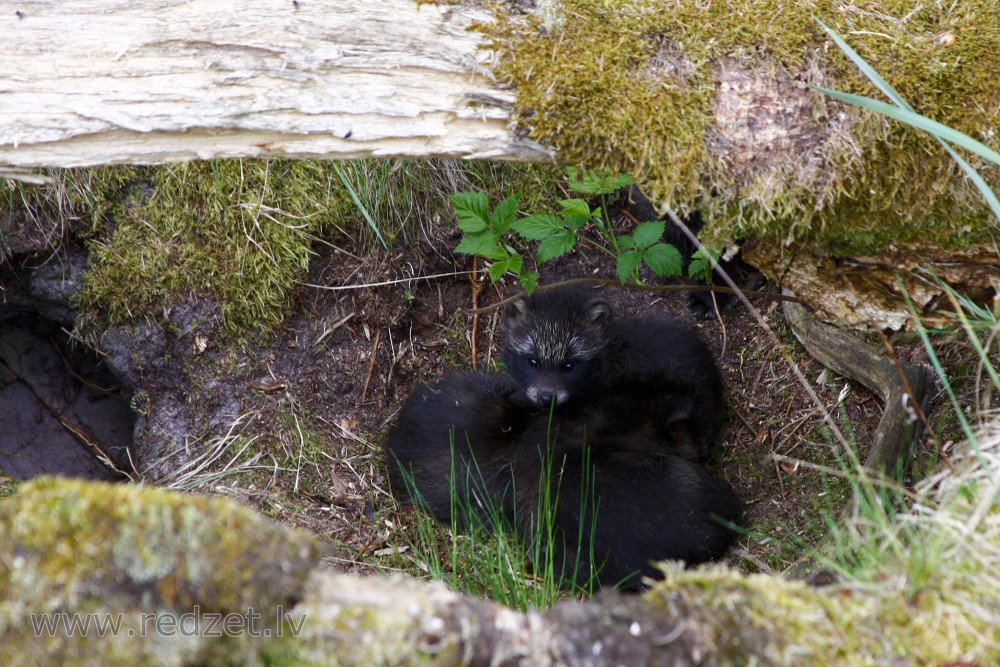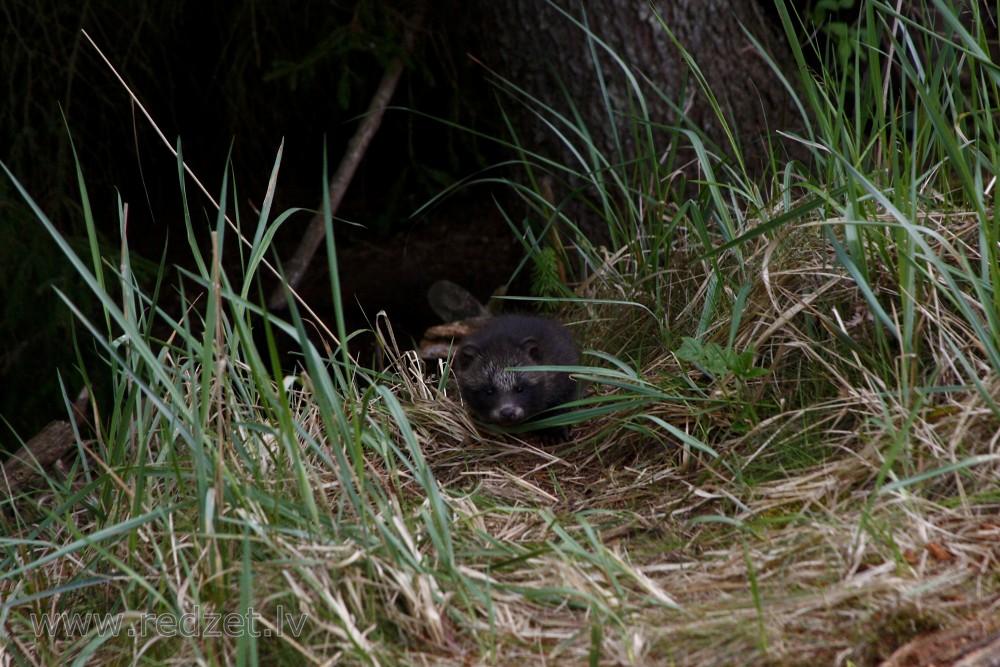Raccoon dog (Nyctereutes procyonoides)
The raccoon dog (Nyctereutes procyonoides, from the Greek words nukt-, "night" + ereutēs, "wanderer" + prokuōn, "before-dog" [but in New Latin used to mean "raccoon"] + -oidēs, "similar to"), also known as the mangut (its Evenki name) is a canid indigenous to East Asia. It is the only extant species in the genusNyctereutes. It is considered a basal canid species, resembling ancestral forms of the family.
Among the Canidae, the raccoon dog shares the habit of regularly climbing trees only with the North American gray fox, another basal species. The raccoon dog is named for its superficial resemblance to the raccoon (Procyon lotor), to which it is not closely related.
Native East Asian raccoon dog populations have declined in recent years due to hunting, fur trade, urbanization, the increase of animals associated with human civilization (such as pets and abandoned animals) and diseases that may be transmitted between them. In Sweden, it has been treated as a potentially hazardous invasive species.
Description
Raccoon dog skulls greatly resemble those of South American foxes, particularly crab-eating foxes, though genetic studies reveal they are not closely related.Their skulls are small, but sturdily built and moderately elongated, with narrow zygomatic arches. The projections of the skull are well developed, the sagittal crest being particularly prominent in old animals.
In reflection of their omnivorous diets, raccoon dogs have small and weak canines and carnassials, flat molars and relatively long intestines (1.5–2 times longer than other canids). They have long torsos and short legs. Total lengths can range from 45 to 71 cm (18 to 28 in). The tail, at 12 to 18 cm (4.7 to 7.1 in) long, is short, amounting to less than 1/3 of the animal's total length and hangs below the tarsal jointswithout touching the ground. The ears are short and protrude only slightly from the fur.
Weights fluctuate according to season: in March they weigh 3 kg (6.6 lbs), while in August to early September males average 6.5–7 kg (14–15 lbs), with some individuals attaining a maximal weight of 9–10 kg (20–22 lb). Specimens from Japanese and Russian studies have been shown to be on average larger than those from Chinese studies.
The winter fur is long and thick with dense underfur and coarse guard hairs measuring 120 mm in length. The winter fur protects raccoon dogs from low temperatures ranging down to −20° to −25 °C. It is of a dirty, earth-brown or brownish-grey colour with black guard hairs. The tail is darker than the torso. A dark stripe is present on the back which broadens on the shoulders, forming a cross shape. The abdomen is yellowish-brown, while the chest is dark brown or blackish. The muzzle is covered in short hair, which increases in length and quantity behind the eyes. The cheeks are coated with long, whisker-like hairs. The summer fur is brighter and reddish-straw coloured.
A rare, white color phase occurs in this species in Japan and in China.
Behavior
Reproduction and development
The mating season begins from early February to late April, depending on location. Raccoon dogs are monogamousanimals, with pair formations usually occurring in autumn. Captive males, however, have been known to mate with four or five females. Males will fight briefly, but not fatally, for mates. Copulation occurs during the night or dawn and will last 6–9 minutes on average. Estrus lasts from a few hours to six days, during which females will mate up to five times. Females will enter estrus again after 20–24 days, even when pregnant.
The gestation period lasts 61–70 days, with pups being born in April–May. Litter sizes on average consist of 6–7 pups, though 15–16 pups can be born in exceptional cases. First-time mothers typically give birth to fewer pups than older ones. Males take an active role in raising the pups. This male role is very significant, as demonstrated by early releases in 1928 of pregnant females without males resulting in very limited success at introduction, while later releases of pairs from 1929 until the 1960s resulted in the raccoon dog's now extensive introduced European range.
Hibernation
Raccoon dogs are the only canids known to hibernate. In early winter, they increase their subcutaneous fat by 18–23% and their internal fat by 3–5%. Animals failing to reach these fat levels usually do not survive the winter. During their hibernation, their metabolism decreases by 25%. In areas such as Primorsky Krai and their introduced range, raccoon dogs only hibernate during severe snowstorms. In December, their physical activity decreases once snow depth reaches 15–20 cm, and will limit the range from their burrows to no more than 150–200 m. Their daily activities increase during February when the females become receptive and when food is more available.
Diet
Raccoon dogs are omnivores that feed on insects, rodents, amphibians, birds, fish, reptiles, molluscs, carrion and insectivores as well as fruits, nuts and berries. Among the rodents targeted by raccoon dogs, voles seem to predominate in swampy areas, but are replaced with gerbils in flatland areas such as Astrakhan. Frogs are the most commonly taken amphibians; in the Voronezh region, they frequently eat fire-bellied toads, while European spadefoot toads are usually taken in Ukraine. Raccoon dogs are able to eat toads which have toxic skin secretions by producing copious amounts of saliva to dilute the toxins. They will prey on waterfowl, passerines, and migrating birds. Grouse are commonly hunted in their introduced range, and many instances of pheasant predation are recorded in the Ussuri territory.
Raccoon dogs will eat beached fish and fish trapped in small water bodies. They rarely catch fish during the spawning season, but will eat many during the spring thaw. In their southern range, they eat young tortoises and their eggs. Insectivorous mammals hunted by raccoon dogs include shrews and hedgehogs and, on rare occasions, moles and desmans. In the Ussuri territory, large moles are their primary source of food. Plant food is highly variable, and includes bulbs, rhizomes, oats, millets, maize, nuts, fruits, berries, grapes, melons, watermelons, pumpkins, and tomatoes. In Japan, they have been observed to climb trees to forage for fruits and berries, using their curved claws to climb.
Raccoon dogs adapt their diets to the season; in late autumn and winter, they feed mostly on rodents, carrion, and feces, while fruit, insects, and amphibians predominate in spring. In summer, they eat fewer rodents, and mainly target nesting birds and fruits, grains, and vegetables.
Vocalizations
Like foxes, they do not bark, uttering instead a growl, followed by a long-drawn melancholy whine. Captive specimens have been known to utter daily a very different kind of sound when hungry, described as a sort of mewing plaint. Males fighting for females will yelp and growl. Japanese raccoon dogs produce sounds higher in pitch than those of domestic dogs, and sound similar to cats.
en.wikipedia.org
https://en.wikipedia.org/wiki/Raccoon_dog
Continue reading




